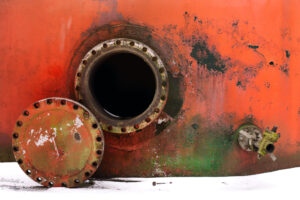Identifying Confined Space Hazards

Safety Talk
Is there a manhole to a sewage system near your workplace, or an underground vault for an electrical system? Any boiler, tunnel, well, silo, shaft or poorly ventilated crawl space can be a potentially dangerous confined space.
WHAT’S AT STAKE
Even if your job doesn’t involve entering a confined space, if there is one nearby it is important to be aware of the dangers. Toxic gas is a common atmospheric hazard. It might be created by a substance stored in the space or seeping in, gasoline vapors from an underground fuel spill or naturally-occurring methane from rotting organic material. Oxygen enrichment can be another atmospheric hazard. Other hazards include flammable gases, vapors or dusts, electric shocks, temperature extremes, shifting materials such as sand, equipment in motion and slippery surfaces.
WHAT CAN GO WRONG
Employees were cleaning a confined space on a vessel using solvents. They were instructed to ventilate the space and dilute any vapors with an air hose. The first shift worker brought in an oxygen hose to ventilate the space. A few hours later, a second worker entered the confined space smoking a cigarette. Upon falling to the ground, the cigarette began to burn. The worker’s attempt to stomp out the cigarette caused his shoe and pant leg to catch fire, spreading rapidly in the oxygen enriched environment and engulfing him in flames.
HOW TO PROTECT YOURSELF
Confined space entry should not be undertaken lightly. It requires training, protective equipment, correct procedures and authorization. Especially in an emergency, you must follow all precautions.
Common procedures for confined space entry, include:
- Getting a written entry permit.
- Wearing proper PPE.
- Assembling tools such as lifelines, retrieval harnesses, testing devices and lighting or communications equipment.
- Testing the air for dangerous gases and oxygen content.
- Preventing pedestrians or vehicles from entering the work area.
- Isolating electrical hazards and closing off lines of flowing liquids or solids.
- Ventilating the area or purging it with inert gas that can’t explode.
- Posting an attendant outside the confined space.
- Removing possible sources of ignition and using non-sparking tools and lighting.
FINAL WORD
Preparing to work safely in a confined space is an involved process that takes special authorization, training and equipment. Do not enter a confined space unprepared — even if it is to rescue someone.